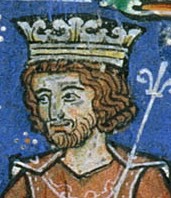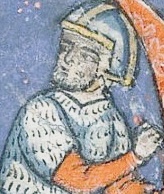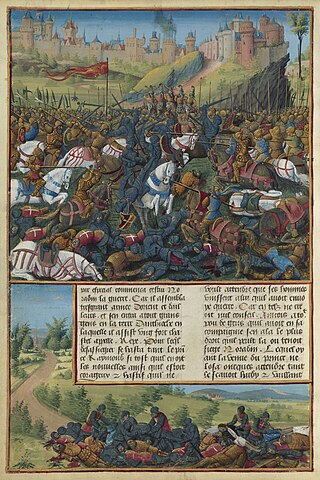
Amalric or Amaury I was King of Jerusalem from 1163, and Count of Jaffa and Ascalon before his accession. He was the second son of Melisende and Fulk of Jerusalem, and succeeded his older brother Baldwin III. During his reign, Jerusalem became more closely allied with the Byzantine Empire, and the two states launched an unsuccessful invasion of Egypt. He was the father of three future rulers of Jerusalem, Sibylla, Baldwin IV, and Isabella I.

Salah al-Din Yusuf ibn Ayyub, commonly known as Saladin, was the founder of the Ayyubid dynasty. Hailing from a Kurdish family, he was the first sultan of both Egypt and Syria. An important figure of the Third Crusade, he spearheaded the Muslim military effort against the Crusader states in the Levant. At the height of his power, the Ayyubid realm spanned Egypt, Syria, Upper Mesopotamia, the Hejaz, Yemen, and Nubia.

Year 1169 (MCLXIX) was a common year starting on Wednesday of the Julian calendar.

Baldwin III was King of Jerusalem from 1143 to 1163. He was the eldest son of Melisende and Fulk of Jerusalem. He became king while still a child, and was at first overshadowed by his mother Melisende, whom he eventually defeated in a civil war. During his reign Jerusalem became more closely allied with the Byzantine Empire, and the Second Crusade tried and failed to conquer Damascus. Baldwin captured the important Egyptian fortress of Ascalon, but also had to deal with the increasing power of Nur ad-Din in Syria. He died childless and was succeeded by his brother Amalric.

Nūr al-Dīn Maḥmūd Zengī, commonly known as Nur ad-Din, was a member of the Zengid dynasty, which ruled the Syrian province (Shām) of the Seljuk Empire. He reigned from 1146 to 1174. He is regarded as an important figure of the Second Crusade.
Mleh I, also Meleh I, was the eighth lord of Armenian Cilicia (1170–1175).

The Battle of Inab, also called Battle of Ard al-Hâtim or Fons Muratus, was fought on 29 June 1149, during the Second Crusade. The Zengid army of Atabeg Nur ad-Din Zangi destroyed the combined army of Prince Raymond of Poitiers and the Assassins of Ali ibn-Wafa. The Principality of Antioch was subsequently pillaged and reduced in size as its eastern border was pushed west.

Asad ad-Dīn Shīrkūh bin Shādhī, also known as Shirkuh, or Şêrko was a Kurdish military commander, and uncle of Saladin. His military and diplomatic efforts in Egypt were a key factor in establishing the Ayyubid dynasty in that country.

Shaizar or Shayzar is a town in northern Syria, administratively part of the Hama Governorate, located northwest of Hama. Nearby localities include, Mahardah, Tremseh, Kafr Hud, Khunayzir and Halfaya. According to the Syria Central Bureau of Statistics (CBS), Shaizar had a population of 5,953 in the 2004 census.
The Battle of Harim (Harenc) was fought on 12 August 1164 at Harim, Syria, between the forces of Nur ad-Din, and a combined army from the County of Tripoli, the Principality of Antioch, the Byzantine Empire, and Armenia. Nur ad-Din won a crushing victory, capturing most of the leaders of the opposing army.

The Battle of al-Babein took place on March 18, 1167, during the third Crusader invasion of Egypt. King Amalric I of Jerusalem, and a Zengid army under Shirkuh, both hoped to take the control of Egypt over from the Fatimid Caliphate. Saladin served as Shirkuh’s highest-ranking officer in the battle. The result was a tactical draw between the forces, however the Crusaders failed to gain access to Egypt.
Qutb al-Din Mawdud was the Zengid Emir of Mosul from 1149 to 1169. He was the son of Imad al-Din Zengi and brother and successor of Sayf al-Din Ghazi I.

Gilbert of Assailly was the fifth Grand Master of the Knights Hospitaller, serving from 1162 or 1163 to 1170, when he was deposed. As Grand Master, he succeeded Auger de Balben. Nevertheless, most sources list him as the fifth, rather than fourth, Grand Master and this biography continues that tradition, with the exception being Delaville Le Roulx' work. He was succeeded by Gastone de Murols. Gilbert encouraged Amalric of Jerusalem in his unsuccessful invasion of Egypt, leaving the Order in debt and causing the reexamination of its military role.
Shawar ibn Mujir al-Sa'di was an Arab de facto ruler of Fatimid Egypt, as its vizier, from December 1162 until his assassination in 1169 by the general Shirkuh, the uncle of the future Ayyubid leader Saladin, with whom he was engaged in a three-way power struggle against the Crusader Amalric I of Jerusalem. Shawar was notorious for continually switching alliances, allying first with one side, and then the other, and even ordering the burning of his own capital city, Fustat, just so that the enemy could not have it.

The Crusader invasions of Egypt (1163–1169) were a series of campaigns undertaken by the Kingdom of Jerusalem to strengthen its position in the Levant by taking advantage of the weakness of Fatimid Egypt.
The military history of the Crusader states begins with the formation of the County of Edessa in 1097 and ends with the loss of Ruad in 1302, the last Christian stronghold in the Holy Land.
Constantine Kalamanos or Coloman was a Byzantine governor of Cilicia.
In the Battle of Lake Huleh in June 1157, a Crusader army led by King Baldwin III of Jerusalem was ambushed and badly defeated by Nur ad-Din Zangi, the emir of Aleppo and Damascus. While the king and some fighting men escaped to a nearby castle, a large number were killed or made prisoner. The Latin Kingdom of Jerusalem escaped worse damage when their adversary became ill and was unable to follow up his victory. The Hula Valley is located in the northeast part of modern-day Israel. At the time of the battle, the area belonged to the Kingdom of Jerusalem.
Saladin in Egypt concerns the history of Egypt from the arrival of Saladin in 1163 and his reign as its leader from 1171 until his death in 1193. Egypt was in a state of decay prior to Saladin's rise to power with the political and social situation in shambles. Saladin first arrived in Egypt alongside his uncle Shirkuh on a campaign launched by Nur al-Din. He would rise to prominence under Shirkuh eventually succeeding him as vizier of Egypt. When the Fatimid Caliphate fell in 1171, Saladin was the only remaining authority in Egypt, he would use his increased power and independence to expand his realm and influence.
Abu'l-Ashbāl al-Ḍirghām ibn ʿĀmir ibn Sawwār al-Lukhamī was an Arab military commander in the service of the Fatimid Caliphate. An excellent warrior and model cavalier, he rose to higher command and scored some successes against the Crusader Kingdom of Jerusalem as well as against internal rebellions. Despite his close personal ties to the viziers Tala'i ibn Ruzzik and his son Ruzzik ibn Tala'i, he joined Shawar when the latter rebelled against Ruzzik and seized the vizierate. Nine months later, Dirgham betrayed Shawar as well and expelled him from the capital, becoming vizier himself on 31 August 1163. Amidst yet another Crusader invasion in 1164, Dirgham clashed with Shawar, who had gained the support of Syrian troops led by Shirkuh. Deserted by most of his troops, Dirgham was killed sometime in May–August 1164 by Shawar's army.












